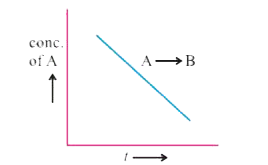The slope of adiabatic curve is _________________than the slope of an isothermal curve.
The correct Answer is:Greater
To determine the relationship between the slopes of adiabatic and isothermal curves, we can follow these steps:
Step 1: Understand the Isothermal Process
The isothermal process is characterized by a constant temperature. For an ideal gas, the relationship between pressure (P) and volume (V) can be expressed as:
PV=nRT
Since nRT is constant at a given temperature, we can rearrange this to find the slope of the isothermal curve.
Step 2: Derive the Slope for the Isothermal Process
To find the slope of the isothermal curve, we differentiate the equation PV=constant:
d(PV)=0
Using the product rule, we have:
PdV+VdP=0
Rearranging gives:
PdV=−VdP
Dividing both sides by dV:
dPdV=−PV
This indicates that the slope of the isothermal curve is negative and is given by:
slopeisothermal=−PV
Step 3: Understand the Adiabatic Process
In an adiabatic process, there is no heat exchange with the surroundings. The relationship for an adiabatic process can be expressed as:
PVγ=constant
where γ (gamma) is the heat capacity ratio (specific heat at constant pressure to specific heat at constant volume).
Step 4: Derive the Slope for the Adiabatic Process
Differentiating the adiabatic equation PVγ=constant:
d(PVγ)=0
Using the product rule:
Pd(Vγ)+VγdP=0
Differentiating Vγ:
γPVγ−1dV+VγdP=0
Rearranging gives:
VγdP=−γPVγ−1dV
Dividing both sides by dV:
dPdV=−γPV
This indicates that the slope of the adiabatic curve is also negative and is given by:
slopeadiabatic=−γPV
Step 5: Compare the Slopes
From the derived slopes, we can see:
- Slope of the isothermal process: −PV
- Slope of the adiabatic process: −γPV
Since γ>1, it follows that:
|slopeadiabatic|>|slopeisothermal|
Thus, the slope of the adiabatic curve is greater in magnitude than that of the isothermal curve.
Conclusion
The slope of the adiabatic curve is greater than the slope of the isothermal curve.
The isothermal process is characterized by a constant temperature. For an ideal gas, the relationship between pressure (P) and volume (V) can be expressed as:
PV=nRT
Since nRT is constant at a given temperature, we can rearrange this to find the slope of the isothermal curve.
To find the slope of the isothermal curve, we differentiate the equation PV=constant:
d(PV)=0
Using the product rule, we have:
PdV+VdP=0
Rearranging gives:
PdV=−VdP
Dividing both sides by dV:
dPdV=−PV
This indicates that the slope of the isothermal curve is negative and is given by:
slopeisothermal=−PV
In an adiabatic process, there is no heat exchange with the surroundings. The relationship for an adiabatic process can be expressed as:
PVγ=constant
where γ (gamma) is the heat capacity ratio (specific heat at constant pressure to specific heat at constant volume).
Differentiating the adiabatic equation PVγ=constant:
d(PVγ)=0
Using the product rule:
Pd(Vγ)+VγdP=0
Differentiating Vγ:
γPVγ−1dV+VγdP=0
Rearranging gives:
VγdP=−γPVγ−1dV
Dividing both sides by dV:
dPdV=−γPV
This indicates that the slope of the adiabatic curve is also negative and is given by:
slopeadiabatic=−γPV
From the derived slopes, we can see:
- Slope of the isothermal process: −PV
- Slope of the adiabatic process: −γPV
|slopeadiabatic|>|slopeisothermal|
Thus, the slope of the adiabatic curve is greater in magnitude than that of the isothermal curve.
The slope of the adiabatic curve is greater than the slope of the isothermal curve.
Topper's Solved these Questions
- BOOK - FIITJEECHAPTER - HEAT AND TEMPERATUREEXERCISE - ASSIGNMENT PROBLEMS (SUBJECTIVE) (level-1) (TRUE OR FALSE QUESTIONS)6videos
HEAT AND TEMPERATURE
- BOOK - FIITJEECHAPTER - HEAT AND TEMPERATUREEXERCISE - ASSIGNMENT PROBLEMS (SUBJECTIVE) (LEVEL II AND III)15videos
HEAT AND TEMPERATURE
- BOOK - FIITJEECHAPTER - HEAT AND TEMPERATUREEXERCISE - ASSIGNMENT PROBLEMS (SUBJECTIVE) (level-1)4videos
HEAT AND TEMPERATURE
- BOOK - FIITJEECHAPTER - GRAVITATIONEXERCISE - Numerical based Question2videos
GRAVITATION
- BOOK - FIITJEECHAPTER - KINEMATICSEXERCISE - NUMERICAL BASED QUESTIONS DECIMAL TYPE5videos
KINEMATICS
Similar Questions
Knowledge Check
- Question 1 - Select One
A gas may expand either adiabatically or isothermally. A number of p−V curves are drawn for the two processes over different ranges of pressure and volume, it will be found that
(i) Two adiabatic curves do not intersect
(ii) two isothermal curves do not intersect
(iii) an adiabatic curve and an isothermal curve may intersect.
(iv) the magnitude of the slope of an adiabatic curve is greater thanthe magnitude of the slope of an isothermal curveA(i),(ii)B(ii),(iii)C(iii),(iv)Dall - Question 2 - Select One
______ measures the slope of indifference curve.
ABudget LineBMarginal Rate of SubstitutionCMarginal Rate of TransformationDNone of these - Question 3 - Select One
The slope of demand curve is generally :
ANegativeBPositiveCConstantDEither (a) or (b)

What is the slope of the curve ?View SolutionDefine slope of TU curve.
View SolutionThe slope of isothermal and adiabatic curves are related as
View SolutionFor a p-V plot, the slope of an adiabatic curve = x × slope of isothermal at the same point. Here x is :
View SolutionIn a p-V diagram for an ideal gas (Where , p is along y-axis and V is along X- axis) , the value of the ratio "slope pof adiabatic curve/ Slope of the isothermal curve"at any point will be (Where symbols have their usual meanings ).
View Solution

